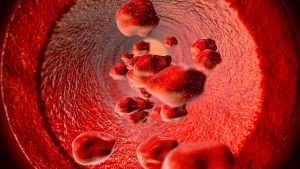 Thrombosis, or deep vein thrombosis (DVT), is a condition where blood clots are formed in veins that are deep inside. This is very common in leg veins and can cause swelling; however, it can be asymptomatic as well. Research shows that patients with chronic kidney disease may be more susceptible to this condition, but it can be prevented or controlled to some extent.
Thrombosis, or deep vein thrombosis (DVT), is a condition where blood clots are formed in veins that are deep inside. This is very common in leg veins and can cause swelling; however, it can be asymptomatic as well. Research shows that patients with chronic kidney disease may be more susceptible to this condition, but it can be prevented or controlled to some extent.
Two aspects are very important when diagnosing this condition—the blood clotting process and overall blood circulation. The way your blood clots and the components, such as platelets, that help in the clotting process may play a role. The blood circulation aspect is important because clots can either block that process partially or they can flow with the blood. If they get carried to vital organs such as lungs, it can lead to a serious health condition called pulmonary embolism that would require immediate medical attention.
Decreased kidney function is associated with an increase in thrombosis
Advertisement
You may wonder why chronic kidney disease patients are susceptible to DVT. Some research has been carried out to study the link between kidney disease and venous thromboembolism (VTE). DVT is one of the forms of VTE. Stats from a study carried out by the teams at the University of Texas Southwestern Medical Center and the University of Vermont, Burlington between 1999 and 2004 reveal that roughly 13 percent of American adults above 20 years of age suffered from kidney disease. Constant changes in blood flow and hypercoagulation due to dialysis are said to increase their susceptibility to DVT. Also, if the patients are immobile or bedridden, it further increases the risk. Additional risk factors are hypertension and diabetes, which have also become extremely common among patients.Stats show that VTE is more common among dialysis patients.
Renal vein thrombosis (RVT) occurs when blood clots are present in the renal vein that carries blood from the kidney. Patients who suffer from nephritic syndrome lose a lot of proteins through their urine and their blood is prone to clotting. These patients are susceptible to RVT.
Aside from this, patients with a tumor in their kidneys, diabetics, as well as those suffering from sickle cell disease and or lupus are at an increased risk of RVT. This condition can be diagnosed by a Doppler ultrasound test or magnetic resonance angiography. Normally, doctors prescribe anticoagulants to control this condition. However, anticoagulants are not the best remedy as they can lead to bleeding complications and excess bleeding post injuries and cuts.
New research that could be useful in the future treatment of thrombosis
The good news is that a research study conducted at the Boston University School of Medicine shows that a regulatory protein called STUB1 could prevent blockages in blood vessels and the abundance of tissue factor (TF). This study was led by Vipul Chitalia, associate professor of medicine, and Katya Ravid, who is a professor of medicine and biochemistry.
They analyzed the TF activity and blood plasma for uremic solutes such as indoxyl sulphate, which is a byproduct of tryptophan. Tryptophan is an amino acid that our body cannot produce,so we must get it through our food intake.Yogurt and other protein-rich foods have tryptophan as one of the amino acid chains. The teams studied samples of 473 patients with advanced chronic kidney disease and arteriovenous (AV) fistula and another group of 377 patients with stage 2 or 3 chronic kidney disease and thrombolysis in myocardial infarction—alternatively known as a heart attack.
The research shows a link between blood clotting, TF activity, and levels of indoxyl sulfate. They also found that patients with arteriovenous fistula had clots with high levels of kynurenine, which is also a uremic solute. Arteriovenous fistula is a condition whereblood clots occur in passages created between veins and arteries through surgeries. This study requires more work and evidence to come up with commercial medications; however, it does show the impact of uremic solutes that lead to thrombosis in patients with different functional levels of kidneys.
To conclude, we can see that treatment and prevention measures for thrombosis are still under research. There is a need to better understand the links between blood coagulation, TF, and uremic solutes. There is also a need to create awareness regarding kidney disease and how it can be prevented or controlled. Likewise, it is also important for the masses to know how to avoid or manage diabetes, hypertension, and other underlying factors that increase the risk of kidney disease and thrombosis through lifestyle changes and proper medical attention.
Advertisement
Related:
Kidney cleanse: How to detox your kidneys naturally
